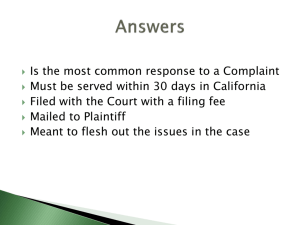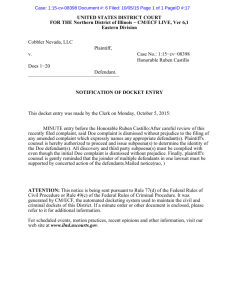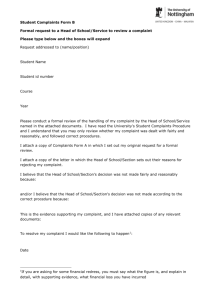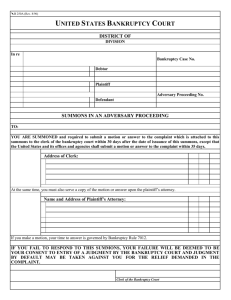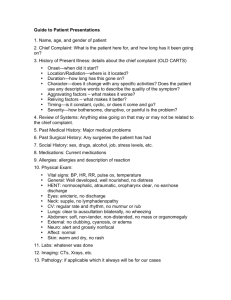Responding to a Lawsuit in California: A Legal Guide
advertisement
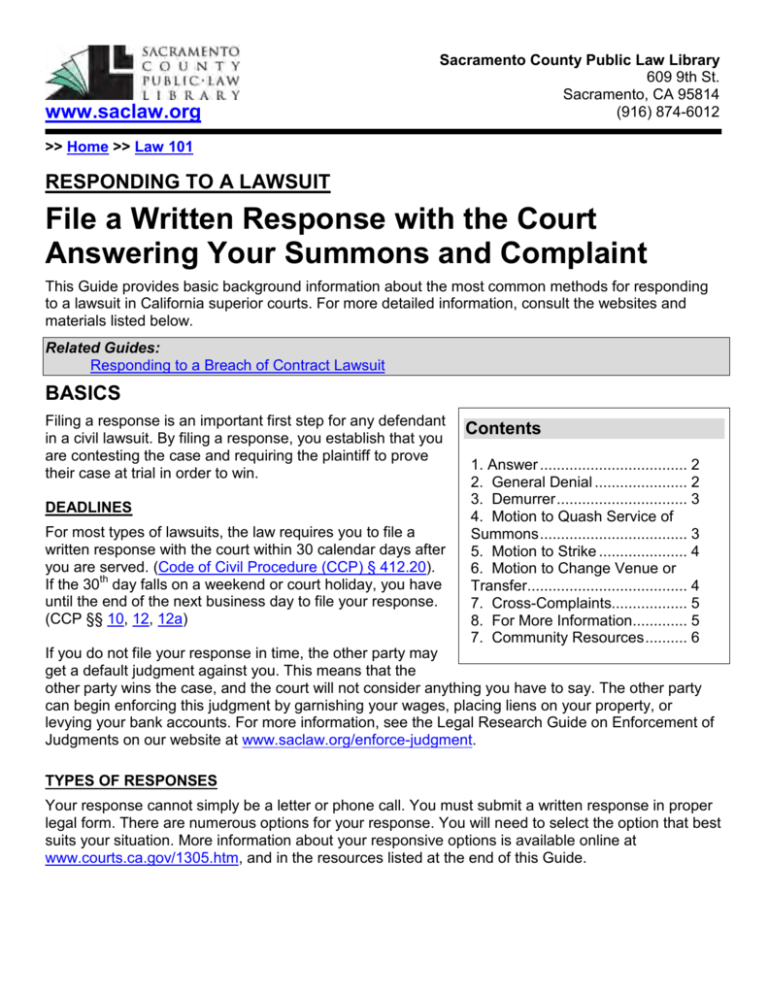
www.saclaw.org Sacramento County Public Law Library 609 9th St. Sacramento, CA 95814 (916) 874-6012 >> Home >> Law 101 RESPONDING TO A LAWSUIT File a Written Response with the Court Answering Your Summons and Complaint This Guide provides basic background information about the most common methods for responding to a lawsuit in California superior courts. For more detailed information, consult the websites and materials listed below. Related Guides: Responding to a Breach of Contract Lawsuit BASICS Filing a response is an important first step for any defendant in a civil lawsuit. By filing a response, you establish that you are contesting the case and requiring the plaintiff to prove their case at trial in order to win. DEADLINES For most types of lawsuits, the law requires you to file a written response with the court within 30 calendar days after you are served. (Code of Civil Procedure (CCP) § 412.20). If the 30th day falls on a weekend or court holiday, you have until the end of the next business day to file your response. (CCP §§ 10, 12, 12a) Contents 1. Answer ................................... 2 2. General Denial ...................... 2 3. Demurrer ............................... 3 4. Motion to Quash Service of Summons ................................... 3 5. Motion to Strike ..................... 4 6. Motion to Change Venue or Transfer...................................... 4 7. Cross-Complaints.................. 5 8. For More Information............. 5 7. Community Resources .......... 6 If you do not file your response in time, the other party may get a default judgment against you. This means that the other party wins the case, and the court will not consider anything you have to say. The other party can begin enforcing this judgment by garnishing your wages, placing liens on your property, or levying your bank accounts. For more information, see the Legal Research Guide on Enforcement of Judgments on our website at www.saclaw.org/enforce-judgment. TYPES OF RESPONSES Your response cannot simply be a letter or phone call. You must submit a written response in proper legal form. There are numerous options for your response. You will need to select the option that best suits your situation. More information about your responsive options is available online at www.courts.ca.gov/1305.htm, and in the resources listed at the end of this Guide. www.saclaw.org Responding to a Lawsuit >>Home >>Law 101 1. Answer An Answer is the most common way to respond to a lawsuit. The Answer is the defendant’s opportunity to admit or deny the specific allegations brought against them in the complaint. Any statements in the complaint that are not denied will be taken as true for the purposes of this case. In the Answer, all defenses to the allegations of the complaint must be raised, and all facts essential to supporting a particular defense must be included. In addition to asserting denials, an Answer may assert any “new matters” constituting a defense (CCP § 431.30(b)(2)). These are called “Affirmative Defenses.” If you do not raise a particular defense in your Answer, you will be prohibited from using or raising it later (see Ekstrom v. Marquesa at Monarch Beach Homeowners Ass'n, 168 Cal. App. 4th 1111 (2008)). Forms: Fill-in-the-blanks forms are available for Answers to specific types of cases: · Answer–Contract (PLD–C–010) · Answer–Personal Injury, Property Damage, Wrongful Death (PLD–PI–003) These forms are also available to copy at the Law Library from West’s California Judicial Council Forms KFC 995 .W45 C3 (Reference). For instructions on completing the Answer-Contract form, see the Step-by-Step guide on Responding to a Breach of Contract Lawsuit on our website at www.saclaw.org/a-k. For instructions on completing Answer–Personal Injury, Property Damage, Wrongful Death (PLD–PI–003), see Win Your Lawsuit, KFC 968 .Z9 D86 (Self-Help), Chap. 8. If these forms do not fit your needs, you can type your Answer on pleading paper. You can find pleading paper formatted for Sacramento County Superior Court for free on our website at www.saclaw.org/pleading-paper-sacramento. Consult the resources listed at the end of this Guide for sample language to use in pleading paper Answers. 2. General Denial A General Denial is a simple response to a lawsuit. In one sentence, the defendant denies every allegation in the complaint. The defendant may also state new matters as affirmative defenses to the complaint. Use of the Judicial Council form is mandatory if the amount asked for is less than $1000. The form may also be used if: 1. the complaint not verified; or 2. the complaint is verified, but is being heard in the limited jurisdiction civil court, unless the case involves a claim for more than $1000 that has been assigned to a third party for collection. A complaint is considered verified if, in the complaint, the plaintiff swears under penalty of perjury that everything is true and correct. Sometimes the verification will be separate from the complaint; other times it will be included at the end of the Complaint itself. www.saclaw.org/respond-to-lawsuit 2 www.saclaw.org Responding to a Lawsuit >>Home >>Law 101 If your case does not meet the guidelines for the mandatory Judicial Council form, you will instead use your Answer to admit or deny each allegation. Forms: If your case meets the guidelines for use of the Judicial Council form: · General Denial (PLD–050) This form is also available to copy at the Law Library from West’s California Judicial Council Forms KFC 995 .W45 C3 (Reference). 3. Demurrer A Demurrer is used to tell the court that the allegations in the complaint do not provide legally sufficient reason for the defendant to be sued. A Demurrer questions only the legal sufficiency of the allegations, not their truth or the plaintiff’s ability to prove them. In the Demurrer, the defendant must state the ways in which the complaint is legally insufficient. The defendant can object to all or just parts of the complaint on various grounds, including: · The complaint fails to state a cause of action · The complaint is uncertain or unclear · Another case is pending between the parties for the same cause of action · The plaintiff does not have the legal capacity to sue Additional grounds for filing a Demurrer can be found in CCP § 430.10. If the Demurrer is overruled, the Defendant must file an Answer to the original complaint within 10 days (California Rules of Court (CRC), Rules 3.1320(g), and (j)). If the Demurrer is sustained with leave to amend the complaint, the Plaintiff can correct the errors in the complaint, serve the Defendant with an Amended Complaint, and the case will proceed. If the Demurrer is sustained without leave to amend the complaint, the case is usually dismissed. Forms: There are no fill-in-the-blanks Demurrer forms. You must create your own Demurrer on pleading paper. You can find pleading paper formatted for Sacramento County Superior Court for free on our website at www.saclaw.org/pleading-paper-sacramento.You can find sample language to write a Demurrer in the resources listed at the end of this Guide. 4. Motion to Quash Service of Summons A Motion to Quash Service of Summons attacks the method the plaintiff used to serve the summons and complaint. Common grounds for a Motion to Quash include: · Defect in the method of serving the summons · Defect in the summons itself · Failure to name the defendant in the summons · Failure to serve the summons altogether www.saclaw.org/respond-to-lawsuit 3 www.saclaw.org Responding to a Lawsuit >>Home >>Law 101 A Motion to Quash based on improper service usually will not dispose of a case permanently. If the plaintiff can properly serve the defendant, the case will proceed. Forms: There are no fill-in-the-blanks Motion to Quash forms. You must create your own Motion to Quash on pleading paper. You can find pleading paper formatted for Sacramento County Superior Court for free on our website at www.saclaw.org/pleading-paper-sacramento. You can find sample language to write a Motion to Quash in the resources listed at the end of this Guide. 5. Motion to Strike With a Motion to Strike, the defendant asks the court to eliminate specific parts of a pleading, including phrases or individual words. In limited jurisdiction cases (under $25,000), parties may only use this motion to attack the “prayer” portion of the complaint, where the plaintiff states the amount of money or relief being requested. In an unlimited jurisdiction case (over $25,000), all or part of a pleading may be deleted on the various grounds set forth in CCP § 436, including: · Material or language that is irrelevant or improper · Material, language, or entire pleadings that are not in compliance with state laws or court orders A Motion to Strike is similar to a Demurrer, in that it challenges defects in the complaint. However, the two pleadings challenge different types of defects. A Demurrer is used to challenge the legal sufficiency or clarity of the claims. A Motion to Strike is used to challenge improper or irrelevant information, or complaints not made in conformity with laws, rules, or court orders. Additionally, a Demurrer is used only to attack entire causes of action, while a Motion to Strike can be used to attack portions of a cause of action. If the Motion to Strike is sustained with leave to amend the complaint, the Plaintiff can file and serve an Amended Complaint, and the case will proceed. If the Motion to Strike is denied, the defendant may file an Answer. Forms: There are no fill-in-the-blanks Motion to Strike forms. You must create your own Motion to Strike on pleading paper. You can find pleading paper formatted for Sacramento County Superior Court for free on our website at www.saclaw.org/pleading-paper-sacramento. You can find sample language to write a Motion to Strike in the resources listed at the end of this Guide. 6. Motion to Change Venue or Transfer A Motion to Change Venue or a Motion to Transfer asks the court to move the case to another court. This can be a court in another county or a different type of court. Be careful of the timing of this type of motion; you will need to allow yourself enough time to file an Answer. See California Civil Courtroom Handbook and Desktop Reference (KFC 995 .Z9 T46) §4:4 and §4:7 for hints on timing this type of motion. 4 www.saclaw.org/respond-to-lawsuit www.saclaw.org Responding to a Lawsuit >>Home >>Law 101 Grounds on which venue can be changed include: · The case was filed in the wrong court · An impartial trial cannot be had in the original court · Witness convenience and the ends of justice are promoted by the transfer · No judge of the court is qualified to act · The case involves the state or a city, county, or local agency Changing venue does not terminate the case; it merely moves it to a different court. Forms: There are no fill-in-the-blanks Motion to Change Venue or Motion to Transfer forms. You must create your own motion on pleading paper. You can find pleading paper formatted for Sacramento County Superior Court for free on our website at www.saclaw.org/pleading-paper-sacramento. You can find sample language for these motions in the resources listed at the end of this Guide. 7. Cross-Complaints If you have a claim that arises out of the same transaction, occurrence, or series of events as the plaintiff’s lawsuit, you must file a Cross-Complaint with your Answer. If your Cross-Complaint is not filed before or at the time you file your Answer, you will need to file complicated paperwork to ask the judge for permission to file your Cross-Complaint. Forms: Fill-in-the-blanks forms are available for Cross-Complaints in specific types of cases: · Cross-Complaint–Personal Injury, Property Damage, Wrongful Death (PLD–PI–002) · Complaint–Contract (PLD–C–001) (check the box for “Cross-Complaint”) These forms are also available to copy at the Law Library from West’s California Judicial Council Forms KFC 995 .W45 C3 (Reference). If these forms do not fit your needs, you can type your Cross-Complaint on pleading paper. You can find pleading paper formatted for Sacramento County Superior Court on our website at www.saclaw.org/pleading-paper-sacramento. Consult the resources listed at the end of this Guide for more information, and for sample language for writing Cross-Complaints. 8. For More Information These resources provide background information, procedural details, and samples of documents needed for procedures listed above. On the Web: Trouble with Money, California Courts Self-Help Website www.courts.ca.gov/selfhelp-problemswithmoney.htm When You've Been Sued - Information for the Defendant, Santa Clara Superior Court Self-Help Website www.scscourt.org/self_help/civil/lawsuits/defendant.shtml www.saclaw.org/respond-to-lawsuit 5 www.saclaw.org Responding to a Lawsuit >>Home >>Law 101 At the Law Library: California Civil Courtroom Handbook and Desktop Reference KFC 995 .Z9 T46 Electronic Access: On the Law Library’s computers, using WestlawNext. California Civil Practice: Procedure KFC 995 .A65 B3 Electronic Access: On the Law Library’s computers, using WestlawNext. California Civil Procedure Before Trial KFC 995 .C34 Electronic Access: On the Law Library’s computers, using OnLaw. California Forms of Pleading and Practice KFC 1010 .A65 C3 (Ready Reference) Electronic Access: On the Law Library’s computers, using the Matthew Bender CD. California Practice Guide: Civil Procedure Before Trial KFC 995 .W45 Electronic Access: On the Law Library’s computers, using WestlawNext. California Pretrial Civil Procedure KFC 995 .M38 Electronic Access: On the Law Library’s computers, using the Matthew Bender CD. Litigation By the Numbers KFC 995 .G67 California Civil Litigation and Discovery KFC 995 .G674 Win Your Lawsuit KFC 968 .Z9 D86 (Self-Help) Electronic Access: From any computer (Law Library or home) via the Legal Information Reference Center. Instructions are available on our website at www.saclaw.org/nolo-ebooks. 7. Community Resources Sacramento County Public Law Library Civil Self-Help Center 609 9th Street, Sacramento 95814 www.saclaw.org/self-help/civil-self-help-center The Sacramento County Public Law Library Civil Self-Help Center provides general information and basic assistance to self-represented litigants on a variety of civil legal issues. Help is provided either through workshops, quick assistance, referrals, or through a limited number of individual appointments. Patrons who are present at 8:30 a.m. will be entered into a random drawing to determine the order their case will be evaluated. If an appointment is appropriate, it will be made for later in the day. You are encouraged to arrive by 8:25 a.m. to participate in the appointment-setting drawing. IF YOU HAVE QUESTIONS ABOUT THIS GUIDE, OR IF YOU NEED HELP FINDING OR USING THE MATERIALS LISTED, DON’T HESITATE TO ASK A REFERENCE LIBRARIAN. H:\public\LRG-SBS\LRGs\RESPONDING TO A LAWSUIT.docx www.saclaw.org/respond-to-lawsuit updated 08/15mpj 6
